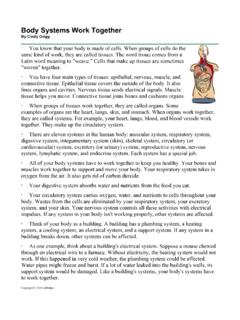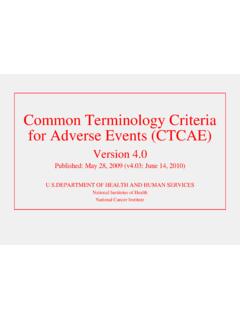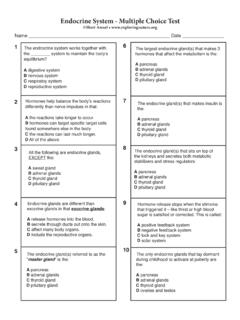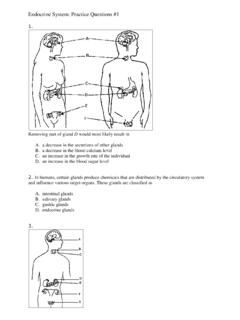Transcription of Endocrine System Overview - Straight A Nursing
1 Endocrine System Overview Endocrine System Nervous System Similarities Chemical messenger is Chemical messenger is Both control organs/systems hormone neurotransmitter to maintain homeostasis Messenger travels long Messengers travel a very Both use chemical distances intercellular short distance. Just travels messengers communication across the synaptic cleft. Made up of glands/tissues Composed of brain, spinal Negative feedback and organs. The structures cord and nerves. They are are not connected. all connected. Wired Wireless System System . ES is not connected to NS is connected to target Both have target cell target organs organs specificity (ligand-receptor specificity). Targets pretty much all cells NS has target cell Some chemical messengers in the body specificity are the same (NE). Requires blood stream for Target cells of the NS are transport muscle, neurons, adipose and glands Slower than NS.
2 Some are Faster than ES. seconds, but most are Milliseconds! minutes, hours or even days Duration of action is longer Activities controlled are than NS skeletal muscle, reflexes, rapid activities Types of activities controlled = pretty much everything not controlled by the NS. Growth, metabolic activity things that require duration. Endocrine System Overview Endocrinology is the study of Endocrine cells/organs, the hormones secreted, regulation of hormone secretion and the effects of hormones on their target cells/organs. Lumen is the inside of Endocrine vs. Exocrine tissues the duct. Endocrine secretes hormones, while exocrine secretes all the other stuff (mucus, enzymes, sweat). Endocrine secretes into the surrounding ISF then into the blood, while exocrine secretes outside the body (skin, digestive tract). Functional anatomy of the Endocrine System Most of the secretory cells are Endocrine cells except for the HOMEOSTASIS EXAMPLE.
3 Neurohormones. These use the blood stream for transport like ADH is released in response to all hormones do, but are secreted from a neuron rather than an low blood volume or low blood Endocrine cell (ex: ADH). Hormones are transported via the pressure. When volume goes up, blood and have target cells, which are the effectors. The blood pressure goes up. When effectors are hormone specific and lead to hormone effects to volume goes down, blood maintain homeostasis. pressure goes down. Secretory ( Endocrine ) cells include these: Endocrine glands o Pituitary glands (6 from the anterior lobe/2 from the posterior). o Pineal Melatonin o Thyroid Thyroid Hormone (TH, T3 & T4). Calcitonin o Thymus Thymosins o Parathyroid PTH (parathyroid hormone). o Adrenal 2 categories catecholamines and corticosteroids Endocrine tissues (within mixed glands).
4 O Pancreatic islets The two biggies are insulin and glucagon o Ovaries (theca interna) Estrogens and progestins (progesterone). o Testes (testes) Androgens (main one is testosterone). Neurosecretory neurons What secretes NE from o Hypothalamus ADH, oxytocin and regulatory Hs the adrenal medulla? o Adrenal medulla NE Post-ganglionic (not epithelial cells, actually modified neurons) sympathetic neurons. Diffuse Endocrine cells o Heart ANP, BNP. o Enteroendocrine cells of GI tract o Liver IGF (insulin-like growth factor). Angiotencinogen Thrombopoietin Calcitriol is the o Kidney Calcitriol active form of Erythropoietin Vitamin D! o Placenta Estrogen, progesterone, HCG. o Adipose Leptin, resistin, grehlin o Skin Vitamin D (the active form). Hormones/Neurohormones Classifications Hormones are organized into classes based on their biochemical structure.
5 O Amines (modified amino acids). They start as AAs (tryptophan or tyrosine), then add side groups and voila! The amine group includes the catecholamines (NE, E, melatonin and TH). o Peptide/protein hormones represent the largest class. o Steroid hormones (all derived from cholesterol). Steroids only come from the gonads, adrenal cortex and the kidneys (calcitriol). Some hormones are tropic! Tropic hormones are nourishing. Tropic hormones target another gland and is usually necessary to maintain Tropic = nourishing. the target tissue. Tropics ALWAYS target Endocrine cells. Tropics are present when H cause the secretion of other Hs. Ex: TRH stimulates release of TSH stimulates release of TH. Synthesis, storage, secretion and distribution of hormones The processes for each class are similar, and are determined by biochemical structure and resulting solubility (lipophobic/hydrophilic or lipophilic/hydrophobic).
6 Peptide/Protein Hormones o Solubility: Water soluble (hydrophilic/lipophobic). o Synthesis: Same general process of protein synthesis. Details not on the test. o Storage: Proteins are stored in vesicles because they cannot get across the vesicle membrane. They are stored until signaled for secretion o Secretion: Exocytosis upon stimulation o Transport: Proteins are transported in the plasma as dissolved particles b/c hydrophilic. Steroid Hormones o Solubility: Lipid soluble (lipophilic/hydrophobic). o Synthesis: Steroids are made from cholesterol. Enzymes modify the cholesterol into steroids such as progesterone, estradiol and testosterone. o Storage: No storage, b/c the molecules would just diffuse across the membrane they cannot be trapped! o Secretion: Diffusion can just diffuse across the membrane o Transport: Bound to protein carriers in the blood.
7 Albumin is the most common carrier. Catecholamines (derivatives of tyrosine) of the Amine Hormones o Solubility: Water soluble (hydrophilic/lipophobic). o Synthesis: Starts with an AA and enzymes modify it. o Storage: Stored in vesicles o Secretion: Exocytosis (NE and E are stimulated via APs from preganglionic axon). o Transport: In the blood as dissolved particles. Note that some bind to proteins in the blood, but this is more so they can be stored don't have to bind to proteins. Thyroid Hormones of the Amine Hormones o Solubility: Lipid soluble (lipophilic/hydrophobic). o Synthesis: We'll go over this later o Storage: Yes, stored in thyroid follicles (more details later). o Secretion: Diffusion (more to come later). o Transport: Bound to carriers o General: TH behaves as a steroid! Melatonin (derivative of tryptophan) of the Amine Hormones o Not much to say here.
8 MECHANISM OF ACTION (MOA) & HORMONE EFFECTS. Hormones bind to specific receptors causing changes in target cell protein activity to produce a cellular response leading to a tissue, organ and organ System response. The types of protein activity affected are: o Protein channels o Protein synthesis o Turning enzymes on or off Hormone receptors are either on the exterior surface of the cell (used by hydrophilic hormones, which are the amines and proteins), or inside the cell (these receptors are used by lipophilic hormones, which are the steroids and thyroid hormone.) The fastest way a hormone could have an affect on a cell is to open a channel, so this role belongs to the hydrophilic amines and proteins. Membrane proteins are cell surface receptors that can be stimulated in one of 3 ways: 1. Membrane protein is part of a fast ligand-gated channel membrane channel.
9 In this case the protein is the channel AND the receptor, so the hormone just binds to the channel itself to cause its effect. OPENS ONLY! The opening of the channel is a brief and immediate response, which changes the permeability of the cell inducing a cellular response. 2. Membrane protein can be part of a G-protein linked, slow ligand-gated channel. This channel opens and closes slooooowwwly. The hormone binds to the receptor, but the receptor has to communicate with other proteins to open the channel. He has to call the handyman to get the door open! This also changes the permeability and electrical properties of the cell. 3. Membrane protein can be part of a 2nd messenger pathway, many of which are mediated by G-proteins. The major 2nd messengers are . a. cAMP. b. cGMP. c. Ca++. The process usually results in the activation or deactivation of enzymes but could also result in indirect, slow opening or closing of membrane channels.
10 When there are changes in enzymatic activity and thus cellular metabolism, this produces a cellular response. The use of a second-messenger results in amplification of the signal from the first messenger, which is the hormone. This explains how one hormone can cause the phosphorylation of up to millions of proteins/enzymes. Intracellular receptors come into play when lipophilic hormones are involved. These receptors are located in the cytosol or the nucleus, which the lipophilic hormone (steroids or TH) can just diffuse right on into. Once attached to the receptor, it forms a hormone- receptor complex that binds to HRE (hormone response element) on the DNA. From this position it affects gene activation (enhances or inhibits), to enhance or inhibit protein synthesis of a specific protein, which leads to the presence or absence of a cellular response.






